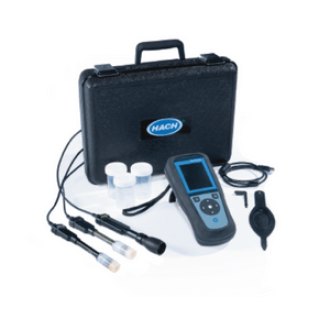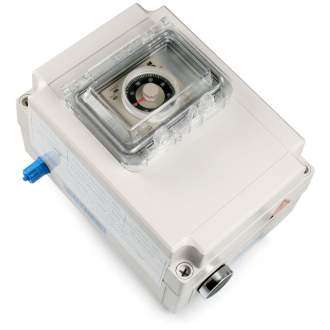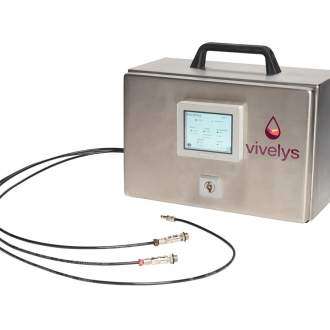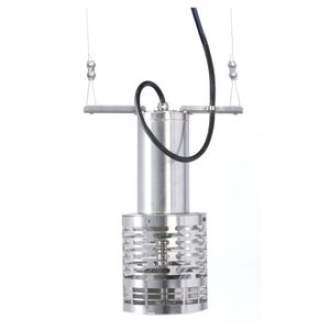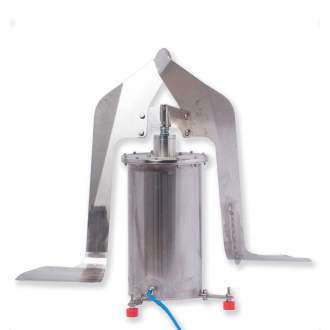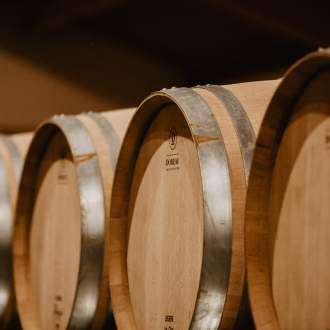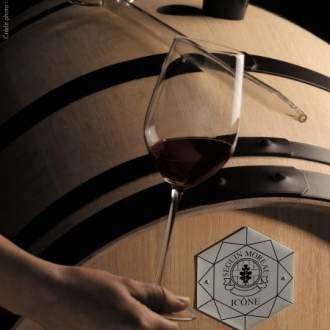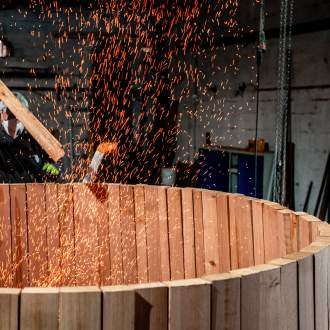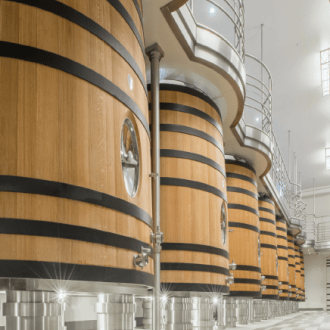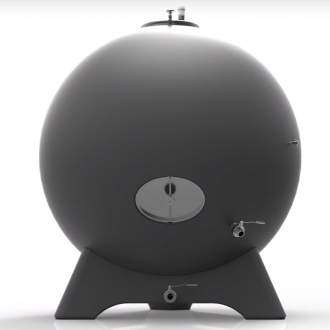Maturation
We understand the concept of aging as the intelligent and well-defined management of the education and molding of the wine during the period necessary to develop the best version of its personality and to give pleasure to the consumer.
That is to say to structure and stabilize, respect and express the fruit, eliminate greenness and polish edges, ultimately making it a great wine.
Whether with wood or without it, in barrels, in casks, in vats, in concrete, in ceramics, in stainless steel, all wines need your attention to develop their potential.
Your task is to correctly interpret the needs of each vintage and adjust the major aging parameters as required by the wine.
The parameters to master?
- Turbidity.
- Oxygen.
- Oak (origen, format, toasted).
- Temperature and humidity.
- Microbiology.
Oxygen
The relationship that exists between oxygen and wine is vital and evolutionary, a relationship of love and hate that is summarized in the sentence by Louis Pasteur “it is oxygen that makes the wine and gives it life, but it is also oxygen that corrupts and destroys it”, hence, in order to bring the fruit and the balance that you have achieved in the vineyard and in winemaking to the consumer, you need tomaster oxygenin the winery.
The effects of oxygen in wine are positive or negative depending on the wine profile, the amount of O2, when the wine dissolves it and how you consume it.
| POSITIVE | NEGATIVE |
| Eliminates oxidizable polyphenols | Oxidizes aromatic precursors |
| Feeds yeasts | Feeds pollutant populations |
| Stabilizes color | Increases the tonality |
| Structure of the wine | Oxidizes free anthocians |
| Rounds the tannins | Increases dryness |
| Oxidizes reducing compounds | Oxidizes aromas |
| Open the wine and increase its expression | Reduces the life of the wine |
To define, how much O2 is needed for a wine must ? When and how do you need it? and What do you need it for? we need to know:
- The dynamics of O2 dissolution and consumption of in musts and wine.
- The effects on the must or wine at each stage of production.
- The needs of each wine according to its maturity.
- The risks of deficiencies and excesses.
- Involuntary contributions linked to movements and operations in the warehouse.
- Measure and interpret oxygen contents from a few parts per billion to saturation.
- What tools do you have to manage the contributions in each container?
Our equipment and consultants can provide the answers you need.
Turbidity
Turbidity during aging mainly comes from the AF and MLF lees. This management has a significant impact on the wine. If you keep them or remove them, if you keep them suspended or lift them from time to time, if you simply leave them at the bottom; the result on the wine will be different depending on the matrix and its aromatic profile.
What do lees do in wine?
- They are great consumers of oxygen, 1,000 times more than the wine itself, so when suspended this protects against oxidation but also closes the wines.
- They release polysaccharides and mannoproteins that increase the fat in wine.
- They increase the reducing power and resistance to oxidation, but when poorly managed they can cause severe reductions.
- They are powerful color absorbers.
- They enhance some aromatic families but inhibit others.
Stirring and aging on lees are very widespread practices that, although they can bring great benefits, we cannot applyas a recipe. For example, if we maintain high turbidity, we will not have the same result in a fermental white as in a thiolic one, or in a light red fresh fruit as in a concentrated ripe fruit. The impact of oxygen is different in a clean red than in a cloudy one, the same happens with oak in its different versions (barrels, foudres or alternatives) the result will not be the same if the turbidity is high than if it is low.
Clean or cloudy, it depends on the needs of each wine, in any case it is important to manage that turbidity with the appropriate tools to avoid excessive oxygen dissolutions or aromatic losses during stirring operations, whether in tanks or in barrels.
Oak
90% of consumers and wine lovers worldwide are willing to pay more for a wine that has had contact with wood.
If we talk about the oak/wine binomial, the image of barrel aging, its flavoring impact and the image and added value it provides to the wine and the winery quickly spring to mind. The barrel and more specifically the Bordeaux format has been the dominant protagonist of aging during the 20th century, but times change and wine with them:
- New consumer trends call for new profiles with fruit as the protagonist and oak as the associate.
- Globalization and the socio-economic situation have forced a rethinking of aging costs
- Advances in the knowledge of oak have opened the doors to new enological benefits beyond aromatization.
Oak experts have been able to respond to these challenges by developing formats and applications that open the doors to new features, new styles, new aging. So today, woodhas become the wine stylist that brings it closer to the perfect balance and precise complexity.
In addition to the flavoring aspect, oak can intervene in many more aspects of wine: fruit, freshness, aromatic expression, sweetness, structure, persistence, volume, complexity and image. Your mission is to correctly interpret the wine matrix of each vintage and master the use of oak in its different formats to achieve the best expression of your wine.
In the mouth, the goal is usually to increase volume, which you can do in 3 aspects depending on the balance of your wine: structure, sweetness and aromatic intensity. The ellagic tannins of the oak add structure and persistance in the mouth. In addition, oak rich in tannins contributes to stabilization of the color and improved expression of the wine to balance its redox status. The more intense the toasting, the fewer tannins are present. Sweetness can be found in the polysaccharides and lactones of slightly toasted woods, or in the degradation compounds of lignins in the most toasted oak, with which you can also sweeten without structuring if you work with chips with low tannin content.
On the nose, oak can solve different challenges: enhance the fruit, ripen or refresh it, mask the vegetal or simply integrate it to keep the dimension fresh, increase complexity, or intensity.
The perception and maturity of the fruit can be increased by the lactones of the untoasted oak. Some volatiles such as eugenol or β-ionone, naturally present in oak, provide a sensation of freshness. The different compounds that are formed according to the intensity of toasting, in addition to their own odorant character, have different effects on the fruit and the expression of the wine. Vanillins, for example, increase the sensation of fruit, integrate the vegetal and open the wines; furfural and other compounds from the heavy toasting help to mask the vegetal, refresh the fruit and close the wine a little. Other furans derived from hemicelluloses give aromas of nuts and roasted fruits.
You will obtain the best organoleptic performance of oak by combining the variables with common sense:
- Wine matrix and target wine profile
- Positioning and cost structure
- Work format (alternatives, barrels, large containers)
- Oak type
- Toasted
- Process
The quality and consistency of our partners and our knowledge of oak-wine interactions are the best allies for the design of your aging. Our consultancies facilitate the path to the optimal combination of these variables.
Chips
ChipsThey are born from the rejection by size in the creasing and sawing of staves, their small size allows very precise, homogeneous and repeatable toasting that offer very specific enological and aging benefits. They are suitable tools for light enological touch-ups and for the construction of profiles on demand in tank aging.
- Quick: extraction in 4 to 10 weeks, and little more for integration.
- Toasting precision, allows surgical enological actions.
- Versatility and repeatability: the precision of each reference allows the construction of oak profiles on demand.
- Possibility of reducing the tannic content, to work sweetness and aroma without dryness.
- Cost optimized.
When working with chips it is important to understand that intensity and complexity are divergent concepts in this format, the more intense a wood is, the less complex it is, and vice versa. Precise aromatic work can be done with low doses of 1 or 2 references; work on complexity will require a higher dosage with mixtures of different toasting levels.
Our advisors and theknow-how of BOISÉ offers the tools to achieve the profiles you want.
Staves and sticks
Like the chips, they come from the rejection by size in the creasing and sawing of staves for barrels, their dimensions allow thermal gradients to be achieved during toasting that will benefit the complexity, in this sense aging with staves can be closer to the barrel concept, structure and complexity.
The sticks are designed to make up for the lack of extractables from old barrels, thus preventing them from drying out the wine
Barrels
Barrel aging requires 3 important decisions:
- < li>When to put the wine in the barrel? the result will be different if you do it before MLF, right after or in spring.
- Choose the right barrel for each wine.
- Establish a filling and transfer policy that helps you conduct oxygenation properly.
The choice of barrel is key for creating a great wine. This requires analysis of the wine's requirements in terms of aroma, structure and oxygen in order to consistently combine the different solutions offered by the cooperage. The parameters to consider:
- Type of oak.
- Grain size.
- Stave thickness.
- Toasted.
- Volume and shape.
Oak barrels define the aromatic range and tannin contribution. American oak is rich in lactones and contributes sweet sensations with coconut aromas. It is a wood with few phenolic and ellagitanic compounds. However, French oak is richer in phenolic compounds and influences the grain size in the wine profile.
The grain size determines the tannin contribution, the aromatic intensity and the speed of release./ The grain depends on the growth rate of the oak; slower growths give trunks fine and extra-fine grain, with a lower proportion of tannins, greater aromatic contribution and a slow release dynamic. The medium grains come from faster growths and give barrels with a greater tannic contribution, less aromatic impact and a faster release, suitable for short aging. We cannot say that one type of grain is more qualitative than another, but rather that they provide different things for different wines.
Thethickness of the stave influences the extraction of ellagitannins from the wood and aromatic components; a 22 mm stave does not provide the same outcome as a 34mm one.
Theamount of toasting, in addition to being the cooper's signature, influences the aromatic range, the sweetness and the tannin contribution. The shape of the brazier, the intensity of the flame, the time and humidity during toasting influence the personality of the barrel and the benefits it offers to the wine. Among the many combinations developed by our coopers, there is sure to be one suitable for your wine.
Thesize and shape of the barrel determine the oxidative capacity and the intensity of all the parameters by the surface/volume ratio. The larger the size, the smaller the contact surface between the wine and the wood.
With theage of the barrel the contribution of aroma and structure decreases, and the contribution of dryness increases. On the other hand, a new barrel offers a direct transfer of the stave compounds and the first wine to be used will be the one that will be most enriched with these compounds.
| FRUIT STYLE | FRENCH OAK | AMERICAN OAK |
| Respect vegetable | Toasted M+ or strong | Toasted M+ with toasted backgrounds |
| Vegetable masking | Toasted M y Grano extrafino | Toasted M without toasted backgrounds |
| Removal of greenery | Toasted Ligero o M | Toasted M without toasted backgrounds |
| Respect fresh fruit | Toasted M+ o MLO | Toasted M+ with toasted backgrounds |
| Ripen fresh fruit | Toasted ligero o M | Toasted M without toasted backgrounds |
| Respect ripe fruit | Toasted M+ | Toasted M+ with toasted backgrounds |
Once the barrel for our wine has been chosen, to achieve a happy ending we need the diffusion, oxidation and evaporation phenomena that occur in the barrel to follow the right path. Therefore, we undoubtedly need permanent control of the basic parameters: temperature, humidity, turbidity, microbiology, filling and racking policy.
The large formats: Tinos and foudres
Over the years, the intensity of wood in wine has undergone different degrees of prominence.
Historically, aging had been conceived in large volume barrels that managed to improve the balance of Iberian grapes by providing a subtle, aged, wooden touch. However, the introduction by law in Bordeaux of the 225-liter barrel as an element of accounting measure, was a very important innovation that gave a new value to aging, a new style in which oak gains great strength and becomes the main actor in its eternal love affair with wine.
Since then, the journey has gone smoothly. However, after several decades managing the aging in Bordeaux barrels almost exclusively, it seems that the consumer's palate seeks to distance itself a little from the oak and to enjoy something closer to the fruit, the freshness and the origin of the wine. Wineries and coopers look back remembering old procedures and recovering past formats with the purpose of changing the roles again.
The know-how of our times allows us to ferment in them, breed, respect, protect and pamper with precision the wine that, one day, took shape in our heads.
Barrels and casks of different capacities offer us the opportunity to work on aspects such as structure, volume, sweetness or fruit from various perspectives, complementary and, most of the time, synergistic, promising us the possibility of designing different encounters between wine and wood that reflect our passion and respond to the taste buds of our public.
Clay
It is a suitable tool for those where the focus is the fruit, wines that require slow oxygenation to stabilize but due to their profile and structure they do not tolerate the contributions of wood.
The properties of clay have been known since ancient times. Its absorbent and refreshing capacity and its slow oxygenation mean that it has been a container for the production and conservation of wine for a long time. Today, we take up what we learned from our ancestors and return to using clay jars for aging wines. The microporous structure facilitates wine/atmosphere exchanges which translate into phenomena that are beneficial for the wine:
- Slow and constant oxygenation that rounds and stabilizes.
- Slow concentration by evaporation.
As in the barrel, the filling policy allows you to adjust the oxygenation dynamics.
Concrete
Concrete is another of the materials used in the past in the production and storage of wines, which once rethought and updated offers us new possibilities for aging.
Thermal inertia, the absence of vibrations and its microporosity are benefits that are adapted to the aging of unique wines when you do not need the contributions of oak.
The atmosphere in the barrel room
We all know that temperature and humidity are critical parameters in the aging and conservation of wines.
- Temperature determines the dynamics of dissolution and oxygen consumption, as well as the speed of the different reactions that take place in aging.
- Moisture takes center stage when we work with porous containers, so it has a qualitative and quantitative influence on evaporation losses.
Wine is a living and sensitive product, small variations in environmental conditions will cause physical or chemical changes that affect its organoleptic quality.
Why do some wines lose fruit during aging and others don't? Too often the answer lies in the conditions of aging and storage, because even knowing their importance, these are parameters that are sometimes overlooked or poorly controlled.
An audit and some environmental readjustments in the barrel room and the finished product room can save a lot of money and a lot of fruit losses and other annoyances.
